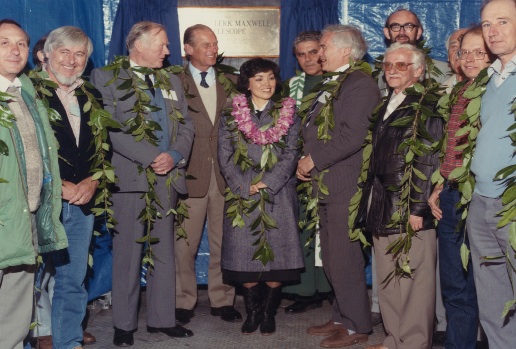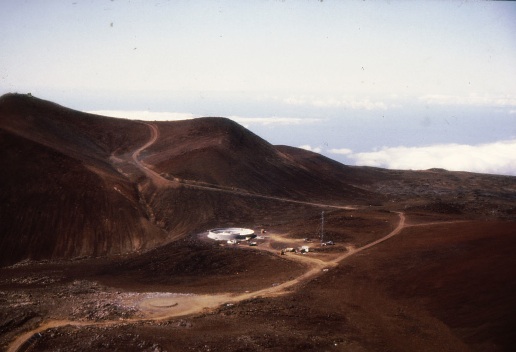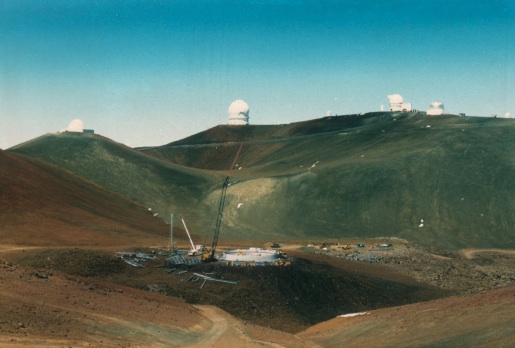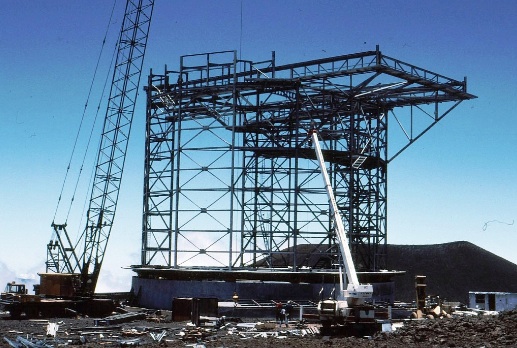A Personal Retrospective by Richard Hills, Cambridge, as it appeared in JCMT Newsletter #36.
After a number of false starts, work on what was then called the UK Millimetre-wave Telescope got underway in 1975. Tom Phillips (then at Queen Mary College) and I (a new post-doc at MRAO) wrote a proposal for a 15m dish with a surface accuracy of < 50μm rms (good enough for operations down to ~800μm wavelength). Items 1 and 2 in the science case were observations of molecular lines and of emission from dust. The focus was on galactic clouds but the prospect of extragalactic research did get a mention. Our first estimate of the cost was £700k, but we thought that we should allow ample margin and so asked for £1.5M. Wise people at the research council “pencilled-in” £2.8M(!), which is roughly £30M at today’s prices. This proved to be (just) sufficient for the telescope and its enclosure, although in those days budgets were adjusted for inflation and exchange rate, and manpower in the Establishments and Universities was not counted.
The management of the project was given to the Appleton Laboratory (AL), which was then at Slough, and they had feasibility studies carried out by Hawker Siddeley and Marconi. The technical results were promising, but it was clear that having a commercial prime contractor was going to be too expensive. The then Project Manager, Barry Shenton, realised that we had to move the design responsibility and risk in-house and proposed that Rutherford Lab (RL) should do it. This was tricky to arrange because AL was fighting a rear-guard action to avoid being merged with RL. The merger was however pushed through and Ron Newport took over the management of the project within the new RAL.
Detailed design work proceeded quite rapidly, but the issue of the site proved more difficult. Although Hawaii was the obvious choice and the “IR Flux Collector” (soon to become UKIRT) was going ahead there, building telescopes on Mauna Kea had already become controversial and we were advised that there was no prospect of getting permission for a second UK telescope. It was therefore decided to site it at what was to be the new UK Northern Hemisphere Observatory on La Palma. Negotiations for the use of that site dragged on, however, and it was not until the end of 1979 that these came to a conclusion. By that time the money that had been in the budget for the UKMT had gone elsewhere and SRC’s budget was being cut, so much of 1980 was spent finding ways to save money. It was the Dutch who came to the rescue by taking a share in the NHO and proposing to join the millimetre-wave project as well.
It was agreed that we should make it a joint project and the name James Clerk Maxwell Telescope was chosen. It was however pointed out by Thijs de Graauw that, if we were serious about the short wavelengths, then La Palma was not really high enough – we should be building it on Mauna Kea. The circumstances in Hawaii had changed by this time and it was thought that approval could be obtained so long as thorough environmental studies were done. The costs on Hawaii were higher and we also needed a better surface accuracy so we could reach the 450μm window, so we proposed to the SRC that the site should be changed and the budget increased. The answer was the inevitable one – we should indeed change the site but there was no extra money. A further round of cost savings ensued in which we reduced the size of the enclosure (but not the dish!) and removed things like a proper control room and an elevator. Gaining the necessary permits in Hawaii took a good deal of time and effort but by spring 1983 we were ready to start work on the foundations. Fortunately we were able to get 1600 tons of concrete in the ground before the next funding crisis hit and less secure projects were axed.
The next item was the steel-work for the enclosure. The fabrication at a works near Bolton only took a few weeks (which surprised me) and they did a trial erection to make sure all the bits fitted and that the rotation and door mechanisms worked. (We did not know then that they had used cheap Russian-made bearings to save money.) Shipping it to Hawaii was more problematic: the large boat that it was scheduled to go on broke down, so the shipping company subcontracted it to a small freighter which was supposed to take it direct to Hilo. We were already somewhat alarmed when the pictures of it setting off showed that the boat was barely visible under the large pile of steel lashed to its deck. After several weeks had passed with no word, investigations revealed that the boat had actually gone to Holland and loaded up with an additional cargo of high explosives. This meant that there was a delay before it could get through the Panama Canal – presumably they have special days for dangerous cargos. It then disappeared again – no doubt to off-load the explosives somewhere on the Pacific coast. By the time it reached Hawaii the penalty clauses for late delivery were nearly equal to the total fee for the charter, and the captain stopped outside the territorial waters and demanded full payment of the original price or he would off-load the steel into the sea! It seems that he did not understand the law of the sea because we were able to obtain a writ for “piracy on the high seas” and the US Coastguard went out and nailed it to the mast. They took possession of the boat and towed it into Hilo.
The fabrication of the steel for the telescope took place in Ijmuiden, near Amsterdam. It again went well and we were able to do a test assembly and first trials of the drives in the factory. This time the shipping went smoothly and by late 1985 the main parts were on the mountain with an enthusiastic team to do the assembly. There were many more exciting moments, such as lifting in the reflector structure: the crane was not large enough to lower it in from the top, so it had to come in through the front, with the building and the crane turning at the same time. There was also a fright when the purpose-built measuring machine proved unable to cope with the amount of vibration on the structure and we had to improvise a holography measurement scheme. Receivers, back-ends, a chopping secondary mirror, a control system and a whole lot of software and other components all arrived from the many collaborating groups in the UK and Holland, and by the end of 1986 we had a just-about-working telescope.
Arrangements for the Canadians to join the project, bringing additional strength to the partnership and saving the SERC from yet another financial crisis, were concluded just in time for the opening ceremony. The opening was mostly memorable for the fact that when the traditional “lever to start the first observation” was pressed, nothing happened: one of the VIP guests was leaning on an emergency stop button! Fortunately this inauspicious start does not seem to have damaged the productivity of the telescope too much.
Overall it was a wonderful project to work on. We had a tremendous amount of fun despite the various delays and setbacks. It is a shame that space does not allow me to name the very many people who worked so hard and unselfishly to make it a success, but I would like to send them all my best wishes and thank them for their contributions.

Dignitaries at the dedication of the JCMT, 27th April 1987. Left to right: Roy Tolcher (Head of Council Works Unit,SERC); Dr Don Hall (University of Hawaii); Sir John Clerk (direct descendant of James Clerk Maxwell); HRH Prince Philip, Duke of Edinburgh; Mrs Lynne Waihee (deputising for her husband, the Governor of Hawaii); Dante Carpenter (Mayor of Hawaii County); Professor Bill Mitchell (Chairman, SERC); Dr Bernard Gingras (NRC, Canada); Dr Paul Williams (Director of the Rutherford Appleton Laboratory, SERC); Dr Albert Mulder (ZWO, Netherlands); Professor Richard Hills (Project Scientist); Brian Edwards (Project Engineer).





